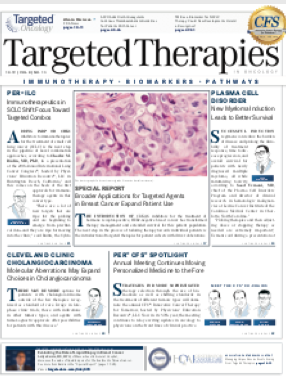Immunotherapeutics in SCLC Shift Focus Toward Targeted Combos
Adding PARP or CHK1 inhibitors to immunotherapies for the treatment of small cell lung cancer is the next step in the pipeline of novel combination approaches, according to Charles M. Rudin, MD, PhD, in a presentation at the <em>20th Annual </em>International Lung Cancer Congress.
Charles M. Rudin, MD, PhD

Charles M. Rudin, MD, PhD
Adding PARP or CHK1 inhibitors to immunotherapies for the treatment of small cell lung cancer (SCLC) is the next step in the pipeline of novel combination approaches, according to Charles M. Rudin, MD, PhD, in a presentation at the20th AnnualInternational Lung Cancer Congress®, hosted by Physicians’ Education Resource®, LLC in Huntington Beach, California,1 and this comes on the heels of the first approvals for immunotherapy agents in this cancer type.
“There are a lot of new targets that are ripe for the picking and are beginning to emerge from preclinical dataand they are ripe for moving into the clinic,” said Rudin, the Sylvia Hassenfeld Chair in Lung Cancer Research, chief of thoracic oncology, and codirector of the Fiona and Stanley Druckenmiller Center for Lung Cancer Research at Memorial Sloan Kettering Cancer Center in New York, New York.
Although lung adenocarcinoma is subtyped with numerous drivers, SCLC is “much less defined when thinking about subsets and drivers, but we think this is beginning to change,” Rudin said. “I think the research in the laboratories is beginning to define subsets of SCLC that may be biologically relevant and potentially therapeutically targetable.”
Preclinical and human data previously led to a model of subtypes based on 4 key transcription regulators believed to be key in driving oncogenic pathways in SCLC: achaete-scute homologue 1 (ASCL1/ASH1), neurogenic differentiation factor 1 (NEUROD1), yes-associated protein 1 (YAP1), and POU class 2 homeobox 3 (POU2F3).2
Prospective research has demonstrated activity for some of these targets, including a phase II trial examining the inhibition of aurora a kinase (AURKA), which has been shown to upregulate YAP, in patients with relapsed SCLC who have c-MYCpositivity. The AURKA inhibitor alisertib (MLN8237) combined with paclitaxel led to a median progression-free survival (PFS) of 4.64 months compared with 2.27 months with placebo/ paclitaxel in patients with c-MYCpositive tumors (HR, 0.29; 95% CI, 0.12-0.72).3
However, in those with c-MYCnegativity, adding the AURKA inhibitor to paclitaxel was associated with a median PFS of 3.32 months versus 5.16 months for placebo and paclitaxel (HR, 11.8; 95% CI, 1.52-91.2).
The Arrival of Immunotherapy
The addition of checkpoint inhibitors to both the frontline and recurrent SCLC settings has been modest, Rudin explained, yet provides a foundation for further research. “It is a significant advance, [and] it is a small advance,” he said. “Both of these [survival] curves are, unfortunately, trending down pretty steeply, so we need to do better. I think this does give us something to build on.”
The first checkpoint inhibitor approved for SCLC was nivolumab (Opdivo), which the FDA indicated for the treatment of patients with SCLC with disease progression following platinum-based chemotherapy and at least 1 other line of therapy (TABLE).3-7The approval was based on data from the phase I/ II CheckMate 032 trial, which showed an objective response rate (ORR) of 12% (95% CI, 6.5%-19.5%) for nivolumab after platinum-based chemotherapy and 1 other prior line of therapy.4
In an exome-sequencing analysis of Check-Mate 032, investigators determined that patients with high tumor mutational burden (TMB) may have greater improvement in overall survival (OS) when treated with nivolumab. Patients with high, medium, and low TMB had a median OS of 5.4 months, 3.9 months, and 3.1 months, respectively; the 1-year OS rates were 35.2%, 26.0%, and 22.1%, respectively.5
In March 2019, the FDA approved the combination of atezolizumab (Tecentriq) with carboplatin and etoposide for the frontline treatment of patients with extensive-stage SCLC. In the phase III IMpower133 trial, results showed that the median OS with atezolizumab was 12.3 months versus 10.3 months in the placebo arm, leading to a 30% reduction in risk of death (HR, 0.70; 95% CI, 0.54-0.91;P= .0069).6
Most recently, in June 2019, the agency granted an accelerated approval to single-agent pembrolizumab (Keytruda) for the treatment of patients with metastatic SCLC who have disease progression on or after platinum-based chemotherapy and at least 1 other prior line of therapy. The decision was based on pooled data from cohorts of the phase II KEYNOTE-158 and phase Ib KEYNOTE-028 trials, which demonstrated that the PD-1 inhibitor elicited a 19% overall response rate (95% CI, 11%-29%) in this patient population.7One set of exciting data in the community, Rudin said, is from the phase III CASPIAN trial of durvalumab (Imfinzi) combined with standard etoposide and platinum-based chemotherapy as a first-line treatment in patients with extensive-stage SCLC. A recent presentation at the International Association for the Study of Lung Cancer's 20th World Congress on Lung Cancer showed the combination demonstrated a statistically significant and clinically meaningful improvement in OS compared with standard chemotherapy alone.8Based on these data, the FDA granted the PD-L1 inhibitor orphan drug status in this space.9
New Directions
Preclinical data have demonstrated that by targeting PARP and CHK1 pathways, there is a significant increase in PD-L1 protein and surface expression.10
Moreover, DNA damage response inhibition activates the STING/TBK1/IRF3 innate immune pathways, which lead to higher levels of CXCL10 and CCL5 chemokines that induce activation and function of cytotoxic T lymphocytes. Overall, this provides a rationale for combining PARP or CHK1 inhibitors with immunotherapy in SCLC. In his presentation, Rudin highlighted 2 preclinical data sets with either the CHK1 inhibitor prexasertib or the PARP inhibitor olaparib (Lynparza), both in combination with an antiPD-L1 antibody.
“These are dramatic interactions between prexasertib [and] the PARP inhibitor olaparib. There seems to be activation through the cGAS/ STING mechanism if you get a DNA damage,” Rudin said. “[Then] you subsequently activate the immune system. The initial data have not been as dramatic as this, but [they do] suggest a way forward if we can optimize the combinatorial properties of chemotherapy and targeted therapies...with immunotherapy.”
The current state of SCLC research is also evolving to focus on defining mechanisms of chemoresistancespecifically, with epigenetic targeting ofSLFN11with EZH2 and evaluating epigenetic vulnerabilities with LSD1 and BRD4.
DLL3, which is highly expressed on SCLC cells, could also be addressed with antibody drug conjugates, bispecific T-cell engagers, chimeric antigen receptor T-cell therapies, and radioconjugates.
Collaborative efforts have been under way to sift through the complexity of SCLC. The National Cancer Institute SCLC Consortium at Memorial Sloan Kettering Cancer Center, for example, is an exchange platform that supports data integration and data analysis, and SCLC researchers meet monthly to discuss research updates.
“This is entirely preclinical, but I think it has been a powerful mechanism for us to learn a lot more about the biology of this disease,” Rudin said.
References
- Rudin CM. Strategies to address unmet needs in small cell lung cancer. Presented at:20th AnnualInternational Lung Cancer Congress®, hosted by Physicians’ Education Resource®, LLC; July 25-27, 2019; Huntington Beach, CA.
- Rudin CM, Poirier JT, Byers LA, et al. Molecular subtypes of small cell lung cancer: a synthesis of human and mouse model data.Nat Rev Cancer. 2019;19(5):289-297. doi: 10.1038/s41568-019-0133-9.
- Owonikoko TK, Nackaerts K, Csoszi T, et al. Randomized phase 2 study of investigational aurora A kinase (AAK) inhibitor alisertib (MLN8237) + paclitaxel (P) vs placebo + P as second line therapy for small-cell lung cancer (SCLC).Ann Oncol. 2016;27(suppl 6):1423O. doi: 10.1093/annonc/ mdw389.01.
- FDA grants nivolumab accelerated approval for third-line treatment of metastatic small cell lung cancer. FDA website. bit.ly/2OiAZ5y. Updated August 20, 2018. Accessed August 19, 2019.
- Hellman MD, Callahan MK, Awad MM, et al. Tumor mutational burden and efficacy of nivolumab monotherapy and in combination with ipilimumab in small-cell lung cancer.Cancer Cell. 2018;33(5):853-861. doi: 10.1016/j. ccell.2018.04.001.
- FDA approves Genentech’s Tecentriq in combination with chemotherapy for the initial treatment of adults with extensive-stage small cell lung cancer [news release]. South San Francisco, CA: Genentech (Roche); March 18, 2019. bit.ly/2Y5jVkw. Accessed August 19, 2019.
- FDA approves Merck’s Keytruda (pembrolizumab) as monotherapy for patients with metastatic small cell lung cancer (SCLC) with disease progression on or after platinum-based chemotherapy and at least one other prior line of therapy [news release]. Kenilworth, NJ: Merck; June 18, 2019. bit.ly/2Kn2Tur. Accessed August 19, 2019.
- L. Paz-Ares, Y. Chen, N. Reinmuth, et al. Overall survival with durvalumab plus etoposide-platinum in first-line extensive-stage SCLC: results from the CASPIAN study. Presented at: International Association for the Study of Lung Cancer's 20th World Conference on Lung Cancer; September 7-10, 2019; Barcelona, Spain. Abstract OA02.02.
- Imfinzi granted US Orphan Drug Designation for small cell lung cancer [news release]. Cambridge, UK: AstraZeneca; July 12, 2019. bit.ly/32lVIIE. Accessed August 19, 2019.
- Sen T, Rodriguez BL, Chen L, et al. Targeting DNA damage response pro- motes antitumor immunity through STING-mediated T-cell activation in small cell lung cancer.Cancer Discov. 2019;9(5):646-661. doi: 10.1158/2159- 8290.CD-18-1020.

Nogapendekin Alfa Plus Checkpoint Inhibition Improves Survival in NSCLC
April 25th 2024Following its recent FDA approval in non-muscle-invasive bladder cancer, nogapendekin alfa has also shown overall survival benefits in addition to checkpoint inhibitor therapy in patients with non-small cell lung cancer.
Read More
Novel Approaches Focus on Limiting Toxicity in Older Patients With ALL
April 22nd 2024The major challenges for clinicians treating older patients with acute lymphoblastic leukemia surround the emergence of resistance to existing therapies and the toxicities associated with current chemotherapies.
Read More